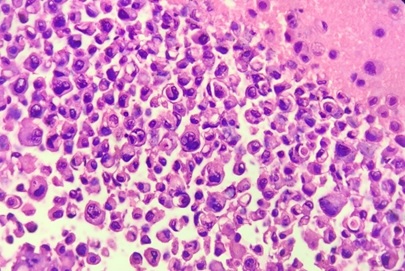Analysis of diagnostic value of cytological smear method versus cell block method in body fluids with clinical and biochemical correlation: study of 150 cases
Abstract
Background: Aspiration of serous cavities is a simple and relatively non-invasive technique to achieve diagnosis. Cytological evaluation of body cavity fluid is diagnostically challenging. Especially in malignant effusions, helps in staging, prognosis and management of the patients.
Aims: To assess the utility and sensitivity of cell block method over conventional smear technique in cytodiagnosis of the serous effusions. And to assess the utility and sensitivity of cytological evaluation of body fluids with biochemical and clinical correlation.
Methods: A total of 150 fluid specimens were examined for conventional cytological smear (CS) and cell block method (CB). Out of 150 fluids, 96 were pleural fluid, 48 were ascitic fluid, 04 fluid from pouch of Douglas and 01 was from synovial fluid.
Results: In this study, the utility of the CB method in the cytodiagnosis of malignant effusions was found to be highly significant as compared to the CS method. The additional yield of malignancy was 12% more as was obtained by the CB method.
Conclusion: For the final cytodiagnosis of body fluid, there is statistically significant difference between the two techniques. In other words, CB is superior to CS method. It gives more information about the architectural arrangement and the likely source of primary. More important is that diagnostic material in cell blocks is available for special studies for Immunohistochemistry which can further supplement our knowledge about the primary source of metastasis.
Downloads
References
Kumar, Abbas, Aster. Robbins and Cotran Pathologic Basis of Disease. 9th ed. Philadelphia, Saunders Elsevier, 2015.
Leopold. Koss’Diagnostic Cytology and its Histopathologic Bases, 5th ed. Philadelphia, J. B. Lippincott, 2006.
Marluce Bibbo, David Wilbur. Comprehensive Cytopathology, 4th ed. Saunders Elsevier, 2015.
Kushwaha R, Shashikala P, Hiremath S, Basavaraj HG. The cells in the pleural fluid and their value in the differential diagnosis. J Cytol, 2008;25:138-43. DOI: 10.4103/0970-9371.50799
Shivakumarswamy U, Arakeri SU, Mahesh H Karigowdar MH, Yelikar BR. Diagnostic utility of the cell block method versus the conventional smear study in pleural fluid cytology. J Cytol 2012;29:11-15. DOI: 10.4103/0970-9371.93210
Dekker A, Bupp PA. The cytology of serous effusions. An investigation into the usefulness of cell blocks versus smears. Am J Clin Pathol 1978;70:855-60. DOI: 10.1093/ajcp/70.6.855
Sears D, Hajdu SI. The cytologic diagnosis of malignant neoplasms in pleural and peritoneal effusions. Acta Cytol 1987;31:85-97.
Wong JW, Pitlik D, Abdul-Karim FW. Cytology of pleural, peritoneal and pericardial fluids in children: A 40 years summary. Acta Cytol 1997;41:467-73. doi: 10.1159/000332540. DOI: 10.1159/000332540
Ghosh I, Dey SK, Das A, Bhattacharjee D, Gangopadhyay S. Cell block cytology in pleural effusion. J Indian Med Assoc. 2012;110(6):390-2, 396.
Fetsch PA, Simsir A, Brosky K, Abati A. Comparison of three commonly used cytologic preparations in effusion immunocytochemistry. Diagn Cytopathol 2002;26:61-66. DOI: 10.1002/dc.10039
Leung SW, Bedard YC. Methods in Pathology. A simple mini block technique for cytology. Mod Pathol 1993; 6:630-32.
Velios F, Griffin J. Examination of the body fluids for tumor cells. Am J Clin Pathol 1954 ; 24: 676-81. DOI: 10.1093/ajcp/24.6.676
Price BA, Ehya H, Lee JH. The significance of the pericellular lacunae in the cell blocks of effusions. Acta Cytol 1992;36:333-37.
Kung IT, Yuen RW, Chan JK. Technical notes. The optimal formalin fixation and the processing schedule of the cell blocks from the fine needle aspirates. Pathology 1989;21:143-45. doi: 10.3109/00313028909059552.
Thapar M, Mishra RK, Sharma A, Goyal V, Goyal V. Critical analysis of cell block versus smear examination in effusions. J Cytol. 2009;26(2):60-4. DOI: 10.4103/0970-9371.55223.
Richardson HL, Koss LG, Simon TR. Evaluation of concomitant use of cytological and histological technique in recognition of cancer in exfoliated material from various sources. Cancer 1955;8:948-50. DOI: 10.1002/1097-0142(1955)8:5<948::aid-cncr2820080515>3.0.co;2-m
Liu K,Dodge K,Glassgow BJ, Layfield LJ. comparison of smears, cytospin & cell block preparation in diagnostic & cost effectiveness. Diagn cytopathol 1998 ;19(1):70-4. DOI: 10.1002/(sici)1097-0339(199807)19:1<70::aid-dc15>3.0.co;2-5
Keyhani-Rofagha S, Vesey-Shecket M. Diagnostic value, feasibility, and validity of preparing cell blocks from fluid-based gynecologic cytology specimens. Cancer Cytopathol 2002; 96: 204– 209. DOI10.1002/cncr.10716

Copyright (c) 2021 Author (s). Published by Siddharth Health Research and Social Welfare Society

This work is licensed under a Creative Commons Attribution 4.0 International License.


 OAI - Open Archives Initiative
OAI - Open Archives Initiative


